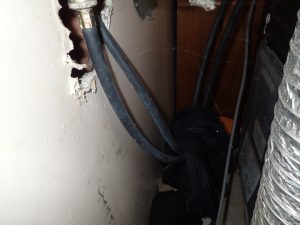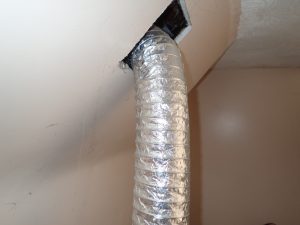Does anyone really enjoy piling all their dirty clothes into a basket and slowly descending the basement stairs to their laundry machines? In the quest for more convenience many people find a way to bring the laundry machines up and out of the deep dark dungeon and into the comfortable living space inside the home. There are a few things to consider when you make this move.
 A washing machine located just down the hall from your bedroom can be a great timesaver if it’s properly installed and maintained. During my home inspections I generally recommend a few upgrades when I find a washer on the same level as living space. Every washing machine that sits on a finished floor should have a drip pan installed underneath. A very small drip at the rear of the machine can go undetected for weeks, months or even years. Without a pan a small leak can get absorbed into the flooring, baseboard or drywall resulting in deterioration and mold damage.
A washing machine located just down the hall from your bedroom can be a great timesaver if it’s properly installed and maintained. During my home inspections I generally recommend a few upgrades when I find a washer on the same level as living space. Every washing machine that sits on a finished floor should have a drip pan installed underneath. A very small drip at the rear of the machine can go undetected for weeks, months or even years. Without a pan a small leak can get absorbed into the flooring, baseboard or drywall resulting in deterioration and mold damage.
In addition to the pan I recommend installation of an automatic water shutoff. This device typically comes with a sensor that sits in the pan under the washing machine and shuts off the water and the power if presence of water is detected. There are less expensive models that simply sound a loud alarm if water is present, but that doesn’t do much good if you forget the washer is operating and decide to run to town for a few errands. By the way, you should always try to run the washer when you’re planning to be home.
 Speaking of water, how about the inlet hoses for the hot and cold water supply to the washer? Some manufacturers supply their own hoses, but most often I see black EPDM or rubber hoses being used. This type of water line is not designed for constant pressure, so the water should be shut off after every load. Who can possibly remember to do that? One alternative is to use braided stainless steel water lines. Even though they still aren’t a guarantee against leaks, they are a fairly inexpensive improvement to the rubber lines and more resistant to bursting.
Speaking of water, how about the inlet hoses for the hot and cold water supply to the washer? Some manufacturers supply their own hoses, but most often I see black EPDM or rubber hoses being used. This type of water line is not designed for constant pressure, so the water should be shut off after every load. Who can possibly remember to do that? One alternative is to use braided stainless steel water lines. Even though they still aren’t a guarantee against leaks, they are a fairly inexpensive improvement to the rubber lines and more resistant to bursting.
As a home inspector I’m much more concerned with safety issues related to the clothes dryer than the clothes washer. Whether the dryer uses gas or electricity, it can get hot enough to start a fire under the right circumstances. When the vent piping gets obstructed with lint such a situation is ripe for starting a fire. I always recommend cleaning out the dryer vent piping on an annual basis. This means brushing and vacuuming the inside of the pipe to remove the lint. I also recommend using either flexible metal or rigid metal vent piping. If a lint fire ever got started inside plastic or foil piping material there’s a pretty good chance it would spread.
